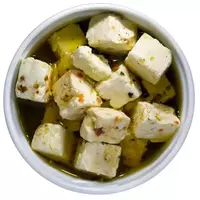Brine cheese

Such a food product as cheese has been familiar to a person since time immemorial. Many researchers claim that people began to make cheeses at the dawn of the development of human civilization. And as often happens, a person discovered a cheese recipe by luck.
Cheeses have been in steady demand and popularity at all times. For no millennia of the existence of such a product as cheese has accumulated just a colossal number of different types and varieties of the product. In modern times, the variety of cheeses can easily capture the imagination of even the most sophisticated foodie. At its core, cheese is a product made from milk, and in some cases cream, as well as cottage cheese or yogurt.
To form a cheese mass, cheesemakers use enzymes, as well as lactic acid bacteria or sourdough. All types and varieties of cheeses in the food industry, however, as in cheese making, are divided into the following main groups, depending on the method of production, taste, and in addition, consumer qualities of the product:
hard cheeses;
soft cheeses;
rennet cheeses;
whey cheeses;
fermented milk cheeses;
cheeses with mold;
brine cheeses.
The main difference between brine cheeses and other varieties of the product can be considered the aging method. All brine cheeses, as the product name implies, are made using a variety of brines. such as brine cheese is kept in brine in order to give the finished product a distinctive consistency, and therefore appearance, taste and consumer characteristics.
Brine cheeses are called varieties such as brynza, Adyghe cheese, suluguni or chechil braid cheese. Brine cheeses are especially popular in the national culinary traditions of the countries of the Caucasus or Transcaucasia. By the way, brine cheeses not only ripen, but are also stored in brine in order to preserve their unique features as long as possible.
Brine cheeses have no cheese crust. The cheese mass of brine cheeses is brittle, and the mass fraction of milk fat content does not exceed 45%. The chemical composition of brine cheeses contains a fairly large amount of salt in comparison with other types of cheese.
All brine cheeses are divided into two main types - soft, for example, brines or hard, the most famous representative of this group of cheeses can be considered suluguni. It is worth noting that the color scheme of brine cheeses can vary depending on the type, as well as the composition of the initial ingredients that are used in the cheese production process. As a rule, the color of brine cheeses is in the range from white to light yellow.
brine cheese 251.9 kCal
Energy value of brine cheese (Ratio of proteins, fats, carbohydrates - ju):
Squirrels: 17.3 (~ 69 kCal)
Fats: 20.3 g (~ 183 kCal)
Carbohydrates: 0 g (~ 0 kCal)
Energy ratio (b | y): 27% | 73% | 0%
 Español
Español Français
Français Português
Português Русский
Русский 简体中文
简体中文 繁體中文
繁體中文 日本語
日本語 한국어
한국어 العربية
العربية Türkçe
Türkçe Қазақ
Қазақ Deutsch
Deutsch Italiano
Italiano Українська
Українська
